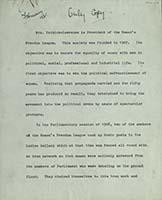Área de identidad
Código de referencia
Título
Fecha(s)
- Feb. 1935 (Creación)
Nivel de descripción
Volumen y soporte
6 single sheets
Área de contexto
Nombre del productor
Institución archivística
Historia archivística
Origen del ingreso o transferencia
Área de contenido y estructura
Alcance y contenido
(Typed, with handwritten alterations.)
—————
Transcript
Mrs. Pethick-Lawrence is President of the Women’s Freedom League. This society was founded in 1907. Its objective was to secure the equality of women with men in political, social, professional and industrial life. Its first objective was to win the political enfranchisement of women. Realising that propaganda carried out for fifty years has {1} produced no result, they determined to bring the movement into the political arena by means of spectacular protests.
In the Parliamentary session of 1908, two of the members of the Women’s Freedom League took up their posts in the Ladies Gallery which at that time was fenced all round with an iron network so that women were entirely screened from the members of Parliament who were debating on the ground floor. They chained themselves to this iron work and threw away the key and this gave them the opportunity, though they themselves were unseen, to address the members of Parliament and to urge them to do justice to women. Police were sent for to remove the women from the Ladies Gallery but since they could not break the chain they had to hammer out a piece of the iron barricade and all the time that this work was being done, the ladies addressed the members of Parliament below.
This incident caused great excitement and the story was sent all over the world by press reporters.
During the same year some of the members showered handbills all over London from a balloon and on another occasion members of the Lords and Commons were address[ed] from a steam launch close to the Terrace of the House of Commons.
In 1909, the House of Commons was “picketed” during the whole Session lasting from July 6th until October 28th. During those months women stood throughout the heat, the rain and the cold all the time that Parliament was in Session and often they had to remain all through the night because there were a number of night Sessions. They stood there holding placards which attracted a large public, & secured a great deal of press publicity.
Then in 1909 the policy was adopted of Tax Resistance. “Taxation without representation is tyranny.” This is a well know[n] political slogan which has been honoured for centuries by men. Women determined that until they could sent their representative to Parliament they would refuse to pay imperial taxes. Many were prosecuted, fined and imprisoned and their property was sold at public auctions. Their demonstrations brought wide publicity and added crowds of new members to their Cause {2}. Caravans toured the country villages during the Summer. Huge open air meetings were held in London parks. In seaside places the women drew great crowds at in† the holiday season and woman’s suffrage became the main topic of conversation throughout the entire country.
During the war, the Women’s Freedom League organised the Woman’s Suffrage National Aid Corps whose chief object was to render help to women anc† children and to nurse in hospitals and convalescent homes. They also formed the Women’s Police Corps and women police volunteers who became known later as the woman’s† Auxiliary service. At the end of the war the first woman’s enfranchisement bill was passed in Parliament.
Years in, years out the Women’s Freedom League continued to work for complete political equality. This was achieved in 1928. The W.F.L. is still active in calling the attention of Parliament to any and every unfairness to women protesting by letter, by deputations, by prompting friendly members of Parliament to put questions in the House. The chief question with which they are concerned at the present moment, is the economic equality of women. The League stands for equal pay for equal work. It claims that all protective industrial legislation should apply to both sexes equally and deprecates restrictions applied only to women because this kind of protection has a tendency to relegate women to the more poorly paid occupations. The League stands for the same right for women to dertermine† their nationality as is exercised by men and also for their right to decide whether they will continue their career when they marry. It advocates the appointment of women in the Police Force and women in Prison Administration. It supports the return of women members of Parliament and advocates the inclusion of women to official positions in the League of Nations.
—————
Typed, with a handwritten alterations. At the top of the first sheet is written ‘February 1935.’ and ‘Only Copy.’
{1} i.e. ‘had’.
{2} The following words are struck through here: ‘all this time. Indoor meetings and outdoor meetings were held over the country. They were explaining to the public the need for women in political life.’
† Sic.
Valorización, destrucción y programación
Acumulaciones
Sistema de arreglo
Área de condiciones de acceso y uso
Condiciones de acceso
Condiciones
Idioma del material
Escritura del material
Notas sobre las lenguas y escrituras
Características físicas y requisitos técnicos
Instrumentos de descripción
Área de materiales relacionados
Existencia y localización de originales
Existencia y localización de copias
Unidades de descripción relacionadas
Área de notas
Identificador/es alternativo(os)
Puntos de acceso
Puntos de acceso por materia
Puntos de acceso por lugar
Puntos de acceso por autoridad
- Women's Freedom League (Materia)
- Woman's Suffrage National Aid Corps (Materia)
- Women's Auxiliary Service (Materia)
- League of Nations (Materia)
Tipo de puntos de acceso
Identificador de la descripción
Identificador de la institución
Reglas y/o convenciones usadas
Estado de elaboración
Nivel de detalle
Fechas de creación revisión eliminación
This description was created by A. C. Green in 2020.

